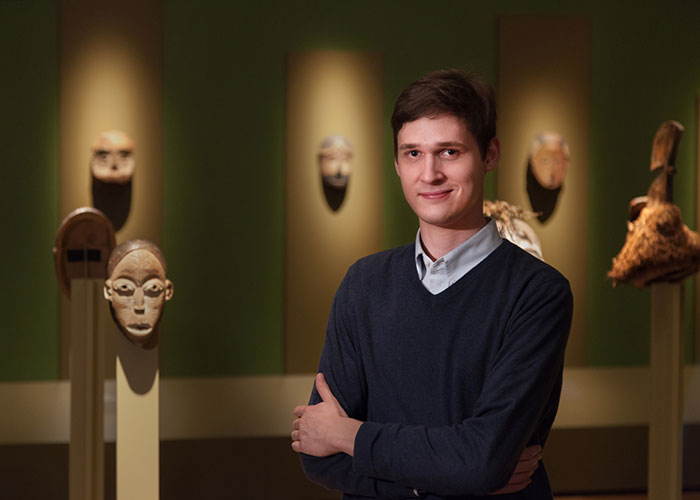
William Neer, VMFA’s curatorial assistant for exhibitions, discusses Congo Masks: Masterpieces from Central Africa, which is curated by Marc Leo Felix, director of the Congo Basin Art History Research Center in Brussels, Belgium. In its only North American venue, the exhibition at VMFA is an innovative and visually compelling display of artistry and cultures, showcasing more than 130 striking Congolese masterpieces. The ticketed exhibition opened November 10, 2018, and runs through February 24, 2019.
In the vast and culturally diverse Congolese region of Central Africa, masks function as performance objects in rituals, ceremonies, worship, and entertainment. They represent the artisans and performers who brought them to life, as well as varied communities, belief systems, and natural resources. In the following Q&A, Neer shares his understanding and deep appreciation for the artistry and cultures highlighted in Congo Masks.
Q: We understand this is the first time these masks will be on view in the United States, can you tell us what makes this exhibition so special?
A: This exhibition is exceptional because it demonstrates a strong comprehensive collection of masks, costumes, and instruments from the Congo region, shown together in the US for the very first time. Some of the objects are well known and have appeared in smaller exhibitions in the past, but they have never before been seen together in such a devoted, thoroughly researched, and dramatic setting. Visitors will find themselves immersed in the exhibition design, which emulates a journey along the nearly 3,000-mile-long Congo River, where environments, peoples, and aesthetics vary regionally. Field photography, footage, and music help to bring the objects to life, in an effort to remind visitors of the original settings, performances, and meanings of these works of art.
Q. What can a visitor expect to learn about the Congo region and its cultures?
A: The Congo Basin is nearly 1.5 million square miles in size and contains hundreds of different peoples, cultures, and languages within it. Visitors can expect to learn about the vast array of function, purpose, and craftsmanship that artwork from this region can possess, and how it reflects local belief systems, myths, histories, social structures, and aesthetics. Masks can mean a number of different things to any given culture, and there is so much to discover as a visitor. The opportunities these works provide for education, entertainment, and cultural understanding are endless.
Q. What were the purposes of these masks and why are they important? And what do they tell us about emotions and the universal human condition?
A: Masks are active presences in their communities, and they meet cultural and societal needs for cohesion, remembrance, justice, divination, entertainment, and more. They act as teaching instruments, behavioral examples, enforcers of law, and can serve as messengers or vessels for powerful spirits of ancestry and nature. Their importance lies not only in community and spiritualism but also in their artistic beauty and impressive craftsmanship. The range of materials and techniques used to create them and imbue them with power is astonishing, and they express a full breadth of human emotion. Through these meaningful objects, visitors can experience feelings and concepts that relate to all of humanity.
Q: How did your perceptions about masking change after working on this exhibition? Do you have a favorite mask? What mask/object/tradition spoke to you the most and why? What was surprising?
A: After working with this exhibition, the complexity and significance of masks, their performance, and their creation has become even clearer to me. These objects’ ability to speak to important moments and emotions in life is palpable and undeniable, and the cultures and peoples they represent are deeply important to acknowledge and understand. One tradition that speaks strongly to me is that of the Chokwe pwo masks, worn to signify powerful female ancestors and decorated with beautiful scarification motifs in the shape of carefully incised geometric forms and bands. I never cease to be surprised by the innovative craftsmanship that has gone into, and continues to go into, Congolese mask making.
